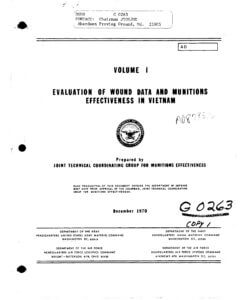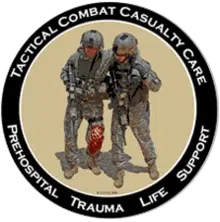Tactical Casualty Care / Tactical Emergency Casualty Care Concepts
What are TCCC and TECC and why are they important?
Our courses teach everything in the TECC and TCCC Guidelines. Those Guidelines have more in common than either committee would like to admit, that’s why our courses are simply Tactical Casualty Care: both deal with traumatic medical events in tactical environments. The primary difference between military combat and an Active Violent Incident is only scope and duration. Getting shot, stabbed, or blown up is the same whether it happens in Iraq, Afghanistan, London, Berlin, Boston, or your city.
 December 1970: Evaluation of Wound Data and Munitions Effectiveness in Vietnam report (WDMET)
December 1970: Evaluation of Wound Data and Munitions Effectiveness in Vietnam report (WDMET)
In December 1970, the military published the Evaluation of Wound Data and Munitions Effectiveness in Vietnam (WDMET) report. This looked in detail at the injury and wounding patterns of 7,800 soldiers and Marines. The report specifically identified which injuries caused the death of US Service Members in Vietnam.
The report was largely ignored for decades since no one wanted to dwell on what killed and injured US Servicemen and women following the Vietnam War. However, by the mid-1980s, I was taught this material at the 18Delta Special Forces Medic course.
The report identified that the 3 primary preventable and treatable causes of death were: massive extremity hemorrhage, tension pneumothorax, and airway occlusion.
1996: Tactical Combat Casualty Care (TCCC)
Fast-forward to 1996 when the first set of Tactical Combat Casualty Care Guidelines were published. TCCC evaluated the WDMET injuries and created best-practice trauma care guidelines customized for use on the battlefield to keep casualties with those injuries from dying. TCCC launched a complete reassessment of battlefield medicine with one goal: Decrease preventable combat death at the point of wounding, resulting in the lowest killed-in-action rate in history.

May 2011: Tactical Emergency Casualty Care (TECC)
Subsequently, a civilian committee was formed and the Tactical Emergency Casualty Care guidelines were created. The TECC guidelines utilized the TCCC guidelines as an evidence-based starting point in the development of civilian-specific medical guidelines for high-threat operations.
The TCCC guidelines were designed for a military population. The TECC guidelines apply to all Americans: Infant to elderly. CPT Drew as chairman of the TCCC committee has said, if you aren’t under DOD, you shouldn’t be using TCCC; you should be using TECC.
April 2013: Hartford Consensus
This material began reaching governmental entities, and on April 2, 2013, representatives from public safety organizations and the US military convened in Hartford, CT to develop a consensus strategy to increase the survival of victims of mass casualty events like Columbine and Sandyhook. Their recommendations are known as the Hartford Consensus.
“The Hartford consensus insists upon basic tactical medical training of every law enforcement officer. Their rationale is that law enforcement officers will be the first responders to any mass injury incident, involving violence (active shooters, domestic bombings, and explosions). Once the immediate threat is contained or stopped, law enforcement officers should play an essential role as bridges between the law enforcement phase of the operation and the integrated rescue response.” 1
October 2015: Stop the Bleed
Next, in October 2015, the US Department of Homeland Security promoted a national awareness campaign to apply this life-saving information to all Americans. Initially promulgated by as part of their community resiliency efforts, this DHS effort culminated in the “Stop the Bleed” campaign. The campaign encourages every American citizen to learn hemorrhage control with bandages and tourniquets so that when confronted with an emergency, there is a grassroots, trained population prepared to help save lives.
Crisis Medicine teaches you to manage these injuries and avoid preventable causes of death wherever you find yourself.
TRAIN NOWOnline Tactical Casualty Care Classes
1. The Hartford Consensus; Threat, A Medical Disaster Preparedness Concept, Jacobs LM, J Am Coll Surg 2013.

 December 1970: Evaluation of Wound Data and Munitions Effectiveness in Vietnam report (WDMET)
December 1970: Evaluation of Wound Data and Munitions Effectiveness in Vietnam report (WDMET)
